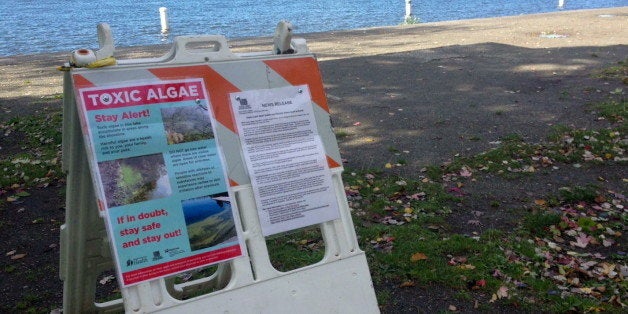
SEATTLE -- Toxic algae blooms appear to be increasing in frequency and intensity around the country, but the full range of their causes -- and their health effects -- remains far from clear. Some experts, meanwhile, are suggesting that lakes, rivers and ponds that breed such blooms are becoming more hazardous thanks in part to a warming planet.
Green Lake, a popular local recreation destination, is no exception. Nearly every morning, Garet Munger and his little black dog, Charlie, make the 3-mile trek around the lake -- which is currently more than living up to its name.
"Right now, there are several locations where the water surface is bright green," said Munger, noting that he has warned other dog owners that they should take seriously the posted warning signs around the lake.
"Many people are aware of the toxic algae, but just think it is okay," he said.
In addition to looking nasty and smelling noxious, some species of cyanobacteria, commonly known as blue-green algae, can pose significant health risks to both pets and people. Last month, a black labrador named Axel died after playing in an Oregon river -- one of dozens of documented dog deaths in recent years pegged to toxic cyanobacteria.
Among the notable humans reportedly sickened by the stuff: Sen. Jim Inhofe (R-Okla.), who swam in a plagued Oklahoma lake in 2011 and subsequently became too ill to keynote a meeting of climate change skeptics.
In the latest report from the Intergovernmental Panel on Climate Change, released last week, researchers project that wet places will generally get wetter and dry places drier, with an increase in extreme weather such as heavy rainfall and heatwaves. In the Pacific Northwest, experts warn of a perfect storm: wetter winters and springs, followed by drier summers. Downpours can flush fertilizers and other favorite foods of toxic algae into lakes and rivers. After the influx of nutrients, a long scorching summer can allow the green slime plenty of time to feed, proliferate, concentrate and out-compete more benign freshwater dwellers that don't grow as well at higher temperatures.
"Blooms are going to be longer and more intense," said Hans Paerl, professor of marine and environmental sciences at the University of North Carolina. "It's all part of the price we're paying for climate change."
Several factors can further help a bloom spiral out of control. Cyanobacteria's tendency to float on the water's surface where it absorbs light, for example, can further increase the water temperature as well as block needed light from reaching its competitors below.
Meanwhile, higher concentrations of carbon dioxide in the atmosphere -- a key factor driving climate change -- can benefit blooming toxic algae, explained Paerl.
"No matter how you look at it, all things happening with climate change are favoring these blooms," he said.
Much of the attention surrounding toxic algae has focused on direct anthropogenic influences: Population growth and shifts in agricultural practices continue to load stormwater runoff with nutrient-rich feces from humans, pets, waterfowl and livestock, as well as lawn and crop fertilizers. Experts believe agricultural inputs, especially for corn, were a major contributor to a roughly 2,000-acre algae bloom two years ago in Lake Erie, as well as other extreme blooms in recent years throughout the Great Lakes.
"We may need to restrict nutrients even more to keep blooms from becoming even more problematic with increased warming," added Paerl.
Just last month, Ohio faced one such problematic consequence of a toxic algae bloom when cyanobacteria contamination forced a water supplier to warn customers not to drink water from their taps.
More common routes of exposure are skin contact, swallowing water while swimming (or licking it off fur, in the case of pets) and eating contaminated fish or shellfish. Evidence is also beginning to emerge that algae toxins could become airborne and inhaled.
Meanwhile, the list of potential health effects continues to grow, from skin rashes to neurological, kidney and liver damage. New research suggests potential increased risks for endocrine disorders and cancer with chronic exposures. The only reported U.S. fatality associated with toxic algae to date was a teenage boy in Wisconsin who played in a scum-covered pond at a golf course.
"But monitoring is sporadic. Many cases aren't captured," said George Luber, an expert in climate change and health with the Centers for Disease Control and Prevention. The CDC has sponsored a surveillance system to help some states, including Ohio and Washington, track blooms and related illnesses.
In the absence of complete data on the potential health risks, and without any federal regulations or official guidance from the U.S. Environmental Protection Agency specifying allowable concentrations of algae toxins in the water, Dina Pierce, a spokeswoman for the Ohio Environmental Protection Agency, noted that her state is among those that have attempted to set their own thresholds to protect the public.
For microcystin, one of the common types of toxic cyanobacteria, Ohio and Washington state have established a limit of 6 micrograms per liter in water bodies. "The World Health Organization recommends a limit of 20, but that didn't take into consideration children's exposures," said Pierce.
The National Wildlife Federation and Resource Media has also lamented the lack of federal standards or consistent monitoring in a report on toxic algae the environmental advocacy groups co-published last week. The report includes an online map of nearly 150 locations with toxic algae blooms between May 5 and Sept. 16.
"We show the national scope of the problem and need for national solution to confront it," said Jordan Lubetkin, a spokesman with National Wildlife Federation, noting that different states are "wildly divergent" in their monitoring and reporting of toxic algae, with some setting thresholds two or three times higher than the WHO benchmark. "The map is probably just the tip of the iceberg."
For example, Green Lake didn't make the map, despite toxic algae blooming at the end of August.
Record rain this April, followed by an unusually dry summer, may have contributed to Green Lake's most recent plague. The spotty nature of some blooms often creates a diagnostic challenge for affected lakes, said Sally Bartley Abella, a toxic algae expert with the King County Water and Land Resources Division in Seattle.
Cyanobacteria's buoyancy means that a small section of the lake can have dangerous levels of microcystin, while an area a few hundred feet away can be safe. "If the wind changes, the patch moves," said Abella.
Officials are currently addressing the problem by placing signs on movable sandwich boards around the lake's perimeter. Each sign warns passersby to stay alert to the danger and includes educational information on blooms. Some of the postings specifically address health risks to dogs.
Joan Hardy's dog, Bella, is pictured on those signs.
"We've also sent mailers to most of the veterinarians in the state to increase awareness," said Hardy, a toxicologist with the Washington Department of Health. With limited funds and without federal standards, animal reports can be a valuable "sentinel for human health," she added.
Also among the sentinels is a volunteer group called Friends of Green Lake, of which Munger is the president. The group collected a water sample on the Friday before Labor Day, sent it to the King County lab for testing and prompted the local agencies' response. "We are the primary set of eyes in terms of things going on," Munger said.
Although the most toxic blooms are often the biggest and most obvious to spot, toxins can linger after a bloom can no longer be seen. A bloom usually peaks in September or October, and then begins to break down, releasing toxins.
"Even in December or January, there might still be detectable algae toxins," said Pierce of the Ohio EPA. "People could have contact while ice fishing."
Specific types of cyanobacteria are also less conspicuous. Cylindrospermopsis, once thought to be strictly tropical or sub-tropical, for example, is now invading freshwater lakes across parts of the U.S., including Lake Erie. The cyanobacteria tends to stay underwater and appears brownish in color, rather than the bright green or red expressed by its cousins.
"We haven't seen that in Washington yet, which is a good thing. But we've learned never to say never," said Abella. "We're still, as a nation, just getting a handle on the magnitude of this problem."

